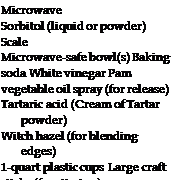 You can find a number of formulas for making your own gelatin on the Internet, as well as purchasing pre-made gelatin prosthetic material from various industry suppliers. When describing gelatin, manufacturers refer to bloom. The bloom factor or bloom strength of gelatin is an industrial standard that measures the relative firmness of the gelatin in a cured state. Gelatin used for makeup effects work usually has a bloom factor of 300, whereas gelatin you can purchase from your local grocer (Knox® brand gelatin, for example) will have a bloom somewhere between 200 and 250.
You can find a number of formulas for making your own gelatin on the Internet, as well as purchasing pre-made gelatin prosthetic material from various industry suppliers. When describing gelatin, manufacturers refer to bloom. The bloom factor or bloom strength of gelatin is an industrial standard that measures the relative firmness of the gelatin in a cured state. Gelatin used for makeup effects work usually has a bloom factor of 300, whereas gelatin you can purchase from your local grocer (Knox® brand gelatin, for example) will have a bloom somewhere between 200 and 250.
This might be just fine for work you will be doing, but just be aware that the tear strength will not be as high as when using a gelatin with a bloom of 300. (The 300 bloom gelatin is also more expensive.) However, there are additives you can put into your gelatin formula that will also increase tear resistance, strength, and durability.

![]()
300 bloom gelatin (U. K. gelatine) Glycerin (U. K. glycerol)
Distilled water Appliance mold Zinc oxide powder Quick rise yeast Epoxy Parfilm (for release)
Elmer’s® Glue (white)
Ascorbic acid powder (vitamin C)
Liquid plastic sealer (alcohol based) Petroleum jelly (for release)
There are so many formulas for making gelatin suitable for prosthetics that I’ve listed every ingredient I remember ever seeing in a recipe. Probably not all of them should be used in the same formula if you want to have a product that is soft, light, and strong enough to use. Fortunately, none of the individual elements is expensive; in fact, gelatin is the least expensive of the prosthetic materials used for makeup effects. Gelatin ingredients are inexpensive, and you can buy just about everything you need to create gelatin appliances at your local grocery store and pharmacy. So experiment, experiment, experiment! Or you can buy pre-made gelatin, both foaming and nonfoaming, that needs only to be heated and poured into a released mold. Several suppliers are listed in the appendix at the back of this book.
Some of the ingredients in the materials list may seem oddly out of place, so let me describe the purposes of some that might not seem obvious:
■ Vinegar: foaming agent
■ Ascorbic acid (vitamin C): foaming agent
■ Baking soda: foaming agent
■ Zinc oxide: strengthener (but will reduce translucency)
■ Tartaric acid: foaming agent
■ Quick-rise yeast: foaming agent
■ Sorbitol: reduces shrinkage, increases strength
■ Elmer’s® Glue: adds strength and stability
